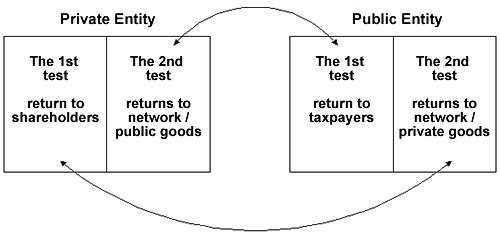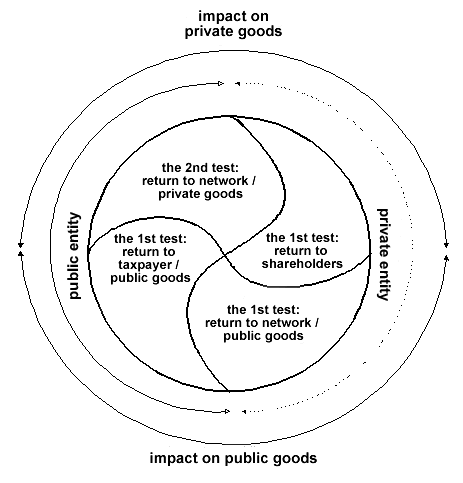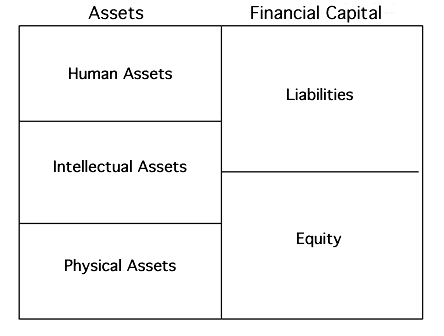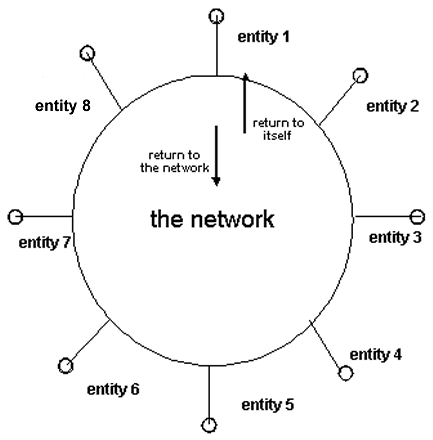
Introduction
I am writing a series of posts on aligning investment with mission and values, including some point-counterpoints with Phil Cubeta at gifthub.org.
I thought I would begin by posting a rewrite of earlier material on an important principle of Solari investment strategy: total economic return.
A discussion of how we analyze and manage investments may not sound like an exciting topic for a Spring weekend. Yet, if we can achieve a consensus on this topic, we can reverse the shift of capital out of the people and enterprises centralizing control of resources in destructive ways.
One of the most powerful opportunities for mission investors is to prototype a successful pathway for capital to shift from the current model where it is functioning in destructive ways to new ones that provide decentralizing, wealth creating solutions. I find the possibility of this happening in a way that yields strong returns for mission investors and their networks more broadly to be quite exciting.
Total Economic Return
An investment’s return is its total economic return. This return can be positive or negative. It can be looked at and measured from various points of view. The first portion of the return is the return to the investor. The second portion of the return involves the return to all the other affected parties in the investment‘s ecosystem. We call the net return to all other parties the return to the network. So, for purposes of definition, an investment‘s return is its total economic return, which is divided into two portions: return on investment to the investor (first test) and return on investment to the network (second test). For a graphic description of this approach, see the flash presentation on the home page at Solari Investment Advisory Services, LLC.
Traditional fiduciary principles say that investors should optimize their risk-adjusted return to investor. Solari investment strategy agrees. Our goal is to see investors achieve the best returns possible. We support doing this by adding the second test as an essential source of strategic intelligence. Think of estimating and tracking returns to the network as an essential navigation tool for the investor.
In Solari investment strategy, significantly greater intellectual mastery of how to create the greatest total economic returns than traditionally required is used to reduce and manage risk and to generate sustained individual investor returns. The Solari investment model adds a new constraint – it is the surgeon‘s motto: “Do no harm.” In other words, use best efforts to invest in enterprises and activities that have a negative network and total economic return. While it is true that theoretically the traditional fiduciary model is supposed to hold to a constraint of the rule of law, simply ensuring that organized crime is profitably managed behind the veil of national security and law enforcement has rendered this constraint almost useless.
Standards of total economic returns necessitate that investors attempt to understand their ecosystem, including the “who” and “what” of the criminality around them. No one who understood total economic returns and followed this practice invested in the housing bubble. The financial advantage of not being part of destroying communities was not losing money when the uneconomic game came crashing down.
|
Transparency – A Necessary Condition
Some of the research that supports this approach is outlined by Robert Axelrod in his 1984 book, “The Evolution of Cooperation.” Axelrod describes his discovery that in an economy with continuous repeat interactions (that is, where repeat interactions are the nature of relationships and “one night stands are not possible), a “tit for tat” strategy is the most successful.
In a “tit for tat“ strategy, one always cooperates, unless and until the other party exploits that cooperation wrongfully, at which point the tit for tat player stops cooperating and attacks back but on a basis where the tit for tat player is willing to return to cooperating after imposing accountability. While the tit for tat player occasionally loses a battle, he or she always wins the war. That is because the tit for tat player attracts the most trustworthy and highest learning speed players as allies over time. In short, “brand” is the defining variable. The trust that comes from excluding dirty players makes speed at complex transactions possible. This is why transparency is an essential condition for cooperative economics.
The merits of Axelrod‘s arguments have been overlooked during a period when the banking, corporate and investment communities have become entirely dependent on hot and dirty money and government intervention and subsidy. As we have seen repeatedly over the last decades, by obfuscating the covert cash flows coming from organized crime and financial corruption, the dirty player wins as they can combine the lowest cost of capital with a socially prestigious brand. We hear repeatedly that pension funds and other fiduciaries must do business with the dirty players because they generate higher investment returns. The result? With the absence of transparency, traditional fiduciary principles are being used to systematically support and promote criminal players and behavior.
Corruption of the current magnitude is not sustainable unless financed in a Slow Burn scenario by significant depopulation. The alternative is to build a critical mass of investors and consumers who can appreciate the opportunity described by Axelrod‘s thesis. In theory, a grassroots movement would be able to provide the necessary enforcement that causes the dirty players to have increasingly higher costs of capital and “tit for tat” players to have lower costs of capitals.
When the marketplace (depositors, consumers, investors) begins to identify and withdraw in size from players that have negative total economic returns or intentionally benefit from reinvestment from players who do and shift instead to players with positive total economic returns, real change can begin.
An Example: Reversing Negative Government Returns
An example that helps us see the power of the “two test“ investment analytics is what I call the “Ben Hur” problem. In the movie Ben Hur, Charlton Heston as Ben Hur is a slave rowing in the galley of a Roman war ship. He asks to be moved to the other side, as he is developing all his muscles on one side. He wants to move to the other side so that he can balance out his muscle development. Investment in the U.S. economy has developed a similar out of balance “Ben Hur”condition.
Generally, most of our resources are governed by private parties or government. In this oversimplified construct, we can see that government‘s investment can be divided into two parts — return on investment to taxpayers and return on investment to the network. In turn, private investment can be viewed in two parts — return to investors (or enterprise) and return on investment to the network.
Oversimplified, the two are flip sides of the same coin.

Understanding the U.S. economy gets much easier when our analytics start to estimate return on government investment and return on private investment as two complimentary parts of one integrated optimization:

As described in detail in “The Myth of the Rule of Law,” and “Dillon, Read & Co. Inc. and the Aristocracy of Stock Profits,” private US investment returns have been subsidized increasingly by government contracts, subsidies, credit, insurance and favorable regulatory and enforcement policies that have produced a negative rate of return on government investment to the taxpayer (i.e., to the government’s network). Some illustrations provided include:
- US Department of Housing and Urban Development (HUD) multifamily housing that cost $150-250,000 per apartment unit in neighborhoods where single-family housing could be provided at only $25-50,000 per home. The justification for such expense by a HUD official was that it would do a better job of “generating fees for our friends.”
- the contract paying a HUD government contractor $206 million to produce consolidated accounting systems that not only were not delivered by the allotted time but, according to the government, resulted in the failure to account for more than $59 billion of agency dollars that we are left to presume have been stolen.
- the reversion of HUD to mortgage default resolutions in 1997 that achieved 70-90% recovery rates back to those which has historically had 35% recovery rates, but were far more conducive to providing back door subsidies to private parties during a housing bubble.
In all cases, we are watching a negative return on investment to taxpayers and negative total economic returns, achieve a positive return on investment for a relatively small group of insiders. The impact on communities of such government credit and subsidy policies has been devastating. A review of the tax payments as well as the mortgage backed securities in the 401(k) and retirement plans of the people living in these communities easily shows that they have been financing their own destruction without even realizing it.What examples like this illustrate is that a high private investment return has been bought at the expense of a negative taxpayer return in a manner which reduces total economic return.
This is an important point. As long as U.S. government investment has a negative total economic return, our economy will worsen. What is rarely understood is the extraordinary improvement possible if the total economic returns of U.S. government investment was continuously engineered to a positive total economic returns. The political problem is of course all the private players who are currently being subsidized – from welfare recipients to large banks and corporations – would have to change and start functioning according to principles of fundamental productivity.
Another way to say this is we are like a sick person who is dying from a Tapeworm. As we weaken, we use more and more of our energy trying to find food that feeds what is good for the Tapeworm. We think we are too tired and too busy to get a proper diagnosis of our problem and to start to feed ourselves what is good for us and bad for the Tapeworm. We have lost all understanding of how strong we can be if we stop doing those things that make us weaker. We don’t see the possible and we have no appreciation for how wonderful things could be. In economic terms, we do not see the human and financial wealth that can be unleashed if we reengineer a negative return on investment to a positive return on investment and overcome the alienation and heartbreak that results from a lifetime of tangled and ever more complex lies.
Which brings us back to the question, how do we create a popular constituency for a return to fundamental productivity? Alas, as long as we can print and borrow money to subsidize ourselves and use our military and covert warfare capability to force others to take our paper, the further off track we can and will go.
Another Example: Making Place Based Assets Visible
The question often comes up as to how it is federal investment returns in particular could have gone so negative without most people noticing it. There are several reasons. Let me focus on two of them.
The first is that most of our assets are not accounted for and tracked by performance. Hence, we have a tendency to optimize only what we have systems to quantify in terms of money or number of units. If we do not count it, let alone profit from it, it is hard to integrate it into our decisions.
The second is the organization of most government budgets and disclosure by function (defense, housing, health care, and so forth) rather than by place as well (so for example, we as citizens do not get the equivalent of an annual report for all government spending, investment, regulation and credit in our Congressional district, which would be logical given the importance of accountability in a governance system.)
This absence of place based accounting for tax-supported resources obfuscates real total economic returns and performance to the individual citizen. Indeed, the finest internal financial control is citizens seeing the financial facts of what government is doing contiguous to the concrete world in which they live and work and vote for political representation.
A civilization’s wealth is its accumulated assets. Real wealth includes:
Human assets – Human resources are people like you and me. This includes our time and health. Many times you will hear the expression, “people are our most valuable resource.” One of the themes that any community will find is the potential value to be created in looking at reengineering alternatives that enhance the use of people‘s time, health and well being within a place. Our time is currently and always will be one of a person‘s single most valuable resource. Our human assets also include our social assets that represent our desire to organize in collectives and communities and communicate in ways that create value and ease confusion and friction.
Intellectual assets the net inherited intelligence of ourselves and our ancestors accessible to us through our knowledge and our tools. Intellectual assets are the intelligence that has been captured and can be transferred or used to leverage other assets in a manner that creates value. It is the books in your library, the maps in your car, the programming language that makes your computer work, or the neural networks that make the whole history of consumer purchases in your place immediately accessible to the newest employee. Intellectual assets include manners and civic and cultural values. We also create art and musical instruments and all sorts of tools that we use for work and for play to make our world safer and more beautiful and to make it easier for us to stay in touch and connected with each other.
Our physical and environmental assets – The world is full of many living things in addition to humans. People are only one of many species. Our planet, Earth, has thousands of acres of land, forests, lakes and ocean and an atmosphere full of oxygen that supports our life. We cultivate and extract from the land and living energy around us to grow our food and grow or make products that make many of our physical assets. We build buildings, roads, bridges, water and sewer systems, electric and gas systems, transportation systems, communication systems and various other forms of property, plant and equipment and “things“ from cars, to lipstick to microwaves to furniture.
Currency and trade have traditionally been used to price and allocate most assets that could be bought, sold or rented. For the last few hundred years, we have tried to improve our ability to allocate our assets through increased use of enterprises such as banks and corporations and the use of financial capital and markets. We move assets into corporate, trust and other legal instruments and then proceed to trade stocks and bonds, or the corresponding options and derivatives. A consolidated balance sheet for our current wealth as a society might look like this:

As new communication technology increases the value of the component of our wealth that is generated by human and intellectual assets, we are faced with a challenge. Our current organizational accounting, internal control, audit and other reporting systems focus almost exclusively on physical and financial assets. Peter Drucker described the problem when he said:
“How knowledge behaves as an economic resource, we do not yet fully understand … We need an economic theory that puts knowledge into the center of the wealth-producing process.”
Only when a company is financed with publicly traded equity do we have a way of estimating the value of its investment in human and intellectual capital. Those who have worked with investing in private venture capital or publicly traded companies generally have a much better understanding of the market value of human and intellectual capital, including “brand“, than their governmental counterparts who have worked in a world financed with debt and who tend to be divorced from understanding or tracking equity performance. Government compensation does not relate to equity creation in the places governed. Unfortunately, many otherwise competent government staffers have been acculturated to believe that government money and the community equity that it impacts is not “real.“
Grappling with the complexity of creating or adapting organizational accounting and information systems that account for human and intellectual capital and other living things ultimately leads to the conclusion that the most productive next step is to provide transparency of government credit, investment and expenditures by place and to finance “places“ with equity.
Increased intelligence is more likely to result from capital gains potential than from highly novel and cumbersome accounting systems. Indeed, such capital gains will incentivize the investment in practical accounting systems that transform our ability to price and invest in what has been traditionally thought of as invisible or shared resources. However, I say this after spending years detailing money flows in communities while managing billions of public and private financial portfolios. I appreciate that these conclusions are far from intuitively obvious to those who have not had access to such pricing and asset data, are used to thinking about money in functional areas or prefer not to think about money at all.
Another Example: Economically Targeted Investments (ETIs)
One response to negative government investment returns is to pressure private investors and lenders to step into the breach in communities with economically targeted investments.
We need to be careful about asking private investors to dispense with performance standards to subsidize low or negative returns on government investment where that avoids dealing with the real problem and even compounds the real problem.
The real problem is often not that some investors are optimizing too much. Rather, it is that government is either optimizing too little or some private investors are manipulating government investment and central banking policy to lower total economic returns to help them inflate their private investor returns in questionable or criminal ways, including at the expense of other private investors.
Total economic returns are low or negative. The solution may not be to invest more capital at the situation or take reduced returns. The solution may require illuminating total economic returns and deal with the drain on fundamental economic productivity of “net energy minus“ investments and players.
How do we get rid of the people and enterprises that are intentionally driving total economic returns negative? Better yet, how do we make money doing it? More bluntly, how do we start to price and delete evil from the system? Is this not a better approach then codependent cleaning up behind it in a way that supports and facilitates evil’s continued existence?
In some situations, more capital investment can break up a monopoly position or shift the state of play in economic warfare. In other situations, however, more capital investment simply subsidizes a harmful situation. Providing easy access to expensive housing and consumer credit to low income communities, as a temporary replacement for savings and income, has certainly helped no one save the people profiting on depopulation, gentrification and fraud at the expense of both communities and global investors.
Fifty years of holding onto the notion that more capital is always good has produced an economy that is highly dependent on organized crime and government subsidy and credit with negative total economic returns.
Indeed, the rise in organized crime and the proliferation of ETIs are not unconnected. A review of the website for the Federal Reserve Bank of New York will show a series of community investments. Any reasonable estimate of the organized crime and corrupt government credit and subsidy flows that “run“ (or disappear) through these neighborhoods would bolster the public relations logic of “doing good“ with a tiny trickle of the potential profits.
ETIs essentially function as bribes or payoffs that then cause more damage in a place by moving it even further from fundamental economics and real productivity. The truth may hurt. However, it is impossible to sustain a positive total economic return without it.
In addition, ETI‘s are also used to promote the brand and social respectability of dirty players, thus moving us away from the conditions necessary for “tit for tat“ players to emerge as those who attract capital. Crime pays. It is socially respectable.
Finally, ETI‘s are also used as a way of shutting off capital to local players. In 1999, I had lunch with the general counsel to the chairman of an important Congressional committee overseeing community development. He told me in no uncertain terms that my ideas for providing small business access to equity capital would not be permitted. In fact, the only capital that would be allowed to flow into minority neighborhoods would go through national not-for-profit tax shelter pools. This meant that small business people would be shut off from access to credit while do-gooders were helping“ the neighborhood would be granted a monopoly position.
ETI’s, in short, were being used as part of a toolkit to control and manipulate the cost of capital within a place at the cost of honest small business people and ethical entepreneurs.
In Conclusion
My pastor in Washington used to say “If we can face it, God can fix it.” Solutions start with the truth. Estimating total economic returns is a way of following the money in search of the truth; holding ourselves and those around us to positive economic returns is a way of sharing responsibility for the overall results. Such a shared financial responsibility is an essential step for a serious broad-based mission investing effort

